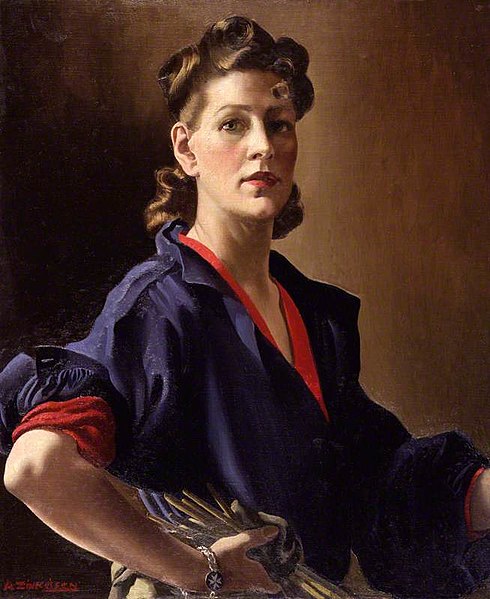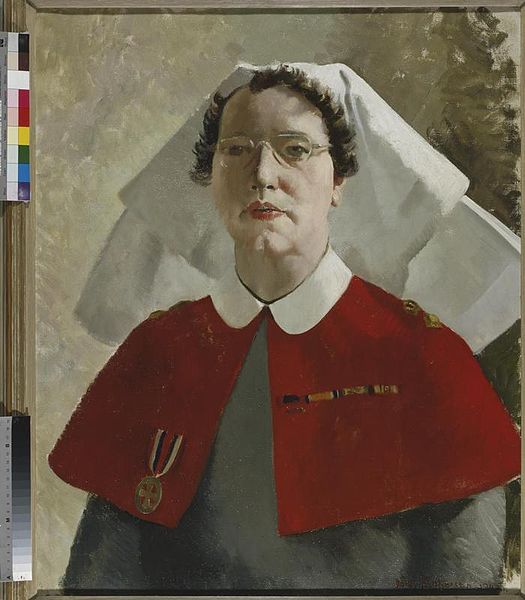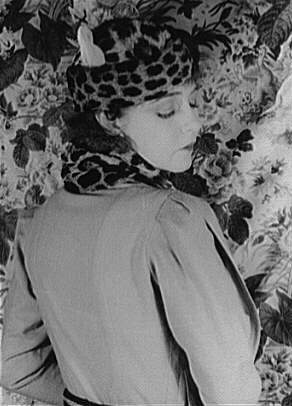They were talented, vivacious, stylish and sassy, and the toast of London’s society. They were the Zinkeisen sisters. Doris and Anna Zinkeisen were the bright young things of the art world during the 1920s and 30s, and rubbed shoulders with the likes of Noel Coward, John Gielgud, and Laurence Olivier.
Although these young ladies appeared to lead a charmed existence, this blog post will focus on their lives away from the glitz and glamour of the smoky jazz clubs and swanky soirees. You will learn about their careers as well respected artists, as well as their voluntary activities during the First and Second World Wars, when both ladies transformed themselves from glamorous party girls into St John Ambulance Voluntary Aid Detachment (VAD) nurses.

Doris and Anna Zinkeisen were born in Scotland in 1898 and 1901 respectively, to Clara Bolton-Charles and Victor Zinkeisen. The family moved to Middlesex in 1909 where the sisters received home tutoring. The girls were constantly in hot water with their governess for sketching and doodling during lessons.

Years later both sisters attended Harrow School of Art where the young siblings showed clear signs of promise. Their unique style coupled with their precocious talent, meant that it was not long before both girls were awarded scholarships to the Royal Academy of Schools in Piccadilly. At this point Anna was still only 15 years old.
The Royal Academy Schools was the first institution in Britain to provide professional training for up and coming artists. It was a hotbed of talent and genius, and Doris and Anna soon became part of a small select circle of talented female artists. During the Royal Academy summer exhibition of 1921, the work of this small circle of young female students ruffled quite a few feathers among the old guard of the older male artists who believed that the work of these young women had no place in the exhibition. In addition to this, the Sunday Express newspaper produced an article which homed in on Doris and Anna. The article stated that traditional art circles were infuriated with the hanging committee’s decision to give these women a prominent position within the exhibition. This controversy surrounding the exhibition and the sisters, helped catapult them into the public domain. They went on to become highly acclaimed society portraitists with the crème de la crème of London and Paris society, scrambling to have their images immortalized in a Zinkeisen portrait. Some of Anna’s subjects included HRH Prince Phillip, Sir Alexander Fleming, and Canadian-British business tycoon, politician, and newspaper publisher, Lord Beaverbrook.

In addition to portraiture, Anna also became a talented sculptress while Doris made a name for herself as a theatrical costume and set designer. She designed costumes for numerous plays and films, including a costume for American stage and screen actress Dorothy Gish, for her portrayal of Nell Gwyn in the 1926 British romantic film of the same name.

In 1928, Doris also designed the costumes for the Noel Coward revue, ‘This Year of Grace’ at the London Pavilion, as well as the set and costume for Laurence Olivier’s 1944 portrayal of Richard III at the Old Vic Company. She was commissioned again in 1955 to design Olivier’s makeup for the film adaptation.
In 1935, Doris and Anna were both commissioned by John Brown and Company Shipbuilders of Clydebank, to paint murals in the Verandah Grill, restaurant, and nightclub on board the ocean liner, RMS Queen Mary. The largest mural was damaged during the Second World War by gunnery officers tacking charts to a poster board which covered the mural. Doris returned to the ocean liner after the war, and restored it to its former glory.
In 1918, Doris and Anna volunteered as St John Ambulance Voluntary Aid Detachment nurses (VADs). Voluntary Aid Detachments were groups of volunteers who among other things provided field nursing services, mainly in hospitals in the United Kingdom, and in various parts of the British Empire. The VADs worked alongside technical and professional staff. The sisters would have been trained in first aid nursing, and would have cared for convalescing soldiers who had been injured at the front.
Doris and Anna volunteered their services again during the Second World War when they both worked as auxiliary nurses for the Order of St John at St Mary’s Hospital in Paddington. They worked in the casualty department helping to nurse air raid victims who had been caught up in the Blitz. By day they nursed war casualties and by night the sisters worked as medical artists. Each night they would commandeer disused operating theatres where they would work on paintings of wounded air raid victims that they had nursed during the day. Anna also created pathological and anatomical drawings of war injuries, complex surgical procedures, and dismembered limbs for the Royal College of Surgeons.
In the early spring of 1945, Doris worked as an official war artist. She was commissioned by the War Artists Advisory Committee which was part of the Ministry of Information, to travel to newly liberated Europe and record the activities of the north west Europe Commission of the Joint War Organization of the Red Cross and the Order of St John.
Doris recorded the commission’s post-war relief activities as well as the rehabilitation and repatriation of prisoners of war. She travelled all over north west Europe by lorry and by air, and also recorded the activities that took place at the liberated Bergen-Belsen concentration camp. She sketched images and took them back to Brussels where she was based, and transformed them into oil paintings.


Doris spent three long days at the Bergen-Belsen camp. Her seductive, vibrant, and sometimes whimsical style that had characterized her society portraits and advertising posters, had been replaced with a style that had become dark and dismal as her subject matter became grittier. Her once flamboyant palette of rich colours had now been replaced with greys, browns, and muted hues, while her images had become both graphic and sobering.
Doris’s experiences at Belsen were harrowing to say the least. In letters that she wrote to her husband, she described the horrendous aftermath of the horrors that had taken place as well as the distinctive nauseating odour that prevailed in and around the camp. She stayed at the camp until it was finally burnt down on the 21 May 1945. She later wrote, “The shock of Belsen was never to be forgotten. First of all was the ghastly smell of typhus. The simply ghastly sight of skeleton bodies just flung out of the huts.”
After the war Anna went back to her commercial work and society portraiture commissions. She was also commissioned by St John Ambulance to produce two paintings for the reproduction of publicity material. The first painting was produced in 1952, and was entitled ‘St John Ambulance Cadets’, and in 1955 she produced a painting entitled ‘St John Ambulance Officer and Nurse’. We have both paintings in our collection.

© Museum of the Order of St John, St John Ambulance.

Doris also returned to her work as a theatrical designer, and occasionally held exhibitions of her paintings. Sadly, the horrors of Belsen were to haunt her for the rest of her life, she later complained that she suffered recurrent nightmares on a nightly basis.
After the death of her husband in 1946, Doris moved to Suffolk with her twin daughters and died at the age of 92 in 1991, while Anna died in London in 1976 aged 75.
Bibliography
Kelleway, P. Highly Desirable: The Zinkeisen Sisters and Their Legacy, 2008
Fotheringham, B. (2011, October) ‘Historical Happenings – Anna Katrina Zinkeisen’. Retrieved from https://www.stjohnsa.com.au/cms_resources/pdf/Historical%20Happenings_10_Oct11.pdf
‘The Zinkeisen Sisters’. (2006, November 13). Retrieved from https://www.scotsman.com/news/the-zinkeisen-sisters-1-725031
Clarke, A. (2009, March 24). http://www.eadt.co.uk/ea-life/gallery-painting-a-portrait-of-cafe-society-1-193484
‘Anna Katrina Zinkeisen’. Retrieved from http://clara.nmwa.org/index.php?g=entity_detail&entity_id=9601


